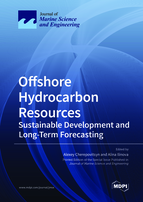Offshore Hydrocarbon Resources: Sustainable Development and Long-Term Forecasting
A special issue of Journal of Marine Science and Engineering (ISSN 2077-1312). This special issue belongs to the section "Geological Oceanography".
Deadline for manuscript submissions: closed (31 March 2021) | Viewed by 35847
Special Issue Editors
Interests: economics of mineral resources; strategic management; sustainable development; economics of CC(U)S
Special Issues, Collections and Topics in MDPI journals
Interests: strategic management; energy economics; industrial management; economics of Arctic mineral resources; economics of CC(U)S
Special Issues, Collections and Topics in MDPI journals
Special Issue Information
Dear Colleagues,
Due to the significant hydrocarbon resources on the Arctic shelf, these territories could eventually become the main oil and gas producing region globally. The main focus of this Special Issue will be on research related to the long-term forecasting of Arctic marine oil and gas resource exploration and development and ensuring the sustainability of the energy sector. The methods and approaches of strategic planning and forecasting, that can be used in modeling the potential of Arctic industrial oil and gas complex and logistic systems, also appear as one of the most important research areas. We hope that research will address issues of ecologically balanced and socially sustainable development of marine and coastal territories of the Arctic. It is necessary to address the problem that innovations, engineering, and management decisions must have a low carbon focus. Moreover, the project risks, including geology and investments, and the interests of all stakeholders of Arctic industrial systems should be fully taken into account. This Special Issue will contribute to the evolution of the methods of strategic planning and forecasting of Arctic marine industrial and logistic complex, based on oil and gas production, in the context of the concept of sustainability.
Prof. Alexey Cherepovitsyn
Dr. Alina Ilinova
Guest Editors
Manuscript Submission Information
Manuscripts should be submitted online at www.mdpi.com by registering and logging in to this website. Once you are registered, click here to go to the submission form. Manuscripts can be submitted until the deadline. All submissions that pass pre-check are peer-reviewed. Accepted papers will be published continuously in the journal (as soon as accepted) and will be listed together on the special issue website. Research articles, review articles as well as short communications are invited. For planned papers, a title and short abstract (about 100 words) can be sent to the Editorial Office for announcement on this website.
Submitted manuscripts should not have been published previously, nor be under consideration for publication elsewhere (except conference proceedings papers). All manuscripts are thoroughly refereed through a single-blind peer-review process. A guide for authors and other relevant information for submission of manuscripts is available on the Instructions for Authors page. Journal of Marine Science and Engineering is an international peer-reviewed open access monthly journal published by MDPI.
Please visit the Instructions for Authors page before submitting a manuscript. The Article Processing Charge (APC) for publication in this open access journal is 2600 CHF (Swiss Francs). Submitted papers should be well formatted and use good English. Authors may use MDPI's English editing service prior to publication or during author revisions.
Keywords
- Hydrocarbon resources
- Marine resources
- Arctic
- Sustainable development
- Forecasting
- Offshore oil and gas fields







